 BSkyB’s Director of Product Management, Gerry O’Sullivan couldn’t help sounding smug as he took centre stage at The Connected Home conference in London today.
BSkyB’s Director of Product Management, Gerry O’Sullivan couldn’t help sounding smug as he took centre stage at The Connected Home conference in London today.
“Those of you who read the papers may have noticed we bought a small Internet company last Friday,” he announced. “To have a combination of satellite distribution and broadband connectivity solves all problems”.
O’Sullivan’s presentation focused on Sky+ and stated the need for a “whole home solution” but he was keen to distance himself from existing IP-based offerings such as the Windows Media Player.
 While Microsoft’s Cynthia Crossley and Telewest’s Mark Horley nodded collaboratively to Merlin Kister of Intel’s assertion that “We mustn’t be close minded and pick a winner. It’s important for all players to work together,” O’Sullivan looked disinterested.
While Microsoft’s Cynthia Crossley and Telewest’s Mark Horley nodded collaboratively to Merlin Kister of Intel’s assertion that “We mustn’t be close minded and pick a winner. It’s important for all players to work together,” O’Sullivan looked disinterested.
“I’m a fan of Media Player – but my mum doesn’t want a reminder to renew her anti-virus subscription while she’s watching Coronation Street,” he said.
And, in response to an audience show of hands revealing nearly all had regular problems with programme crashes on their PCs, O’Sullivan added:
 “There’s zero tolerance (among our customers) for that sort of unreliability and pain…we can only roll out products that you switch on and they work.”
“There’s zero tolerance (among our customers) for that sort of unreliability and pain…we can only roll out products that you switch on and they work.”
And BSkyB has the money and ambition to keep turning out products it thinks consumers may need – the five day old Sky Gnome for example, enabling you to listen to satellite radio in the garden, or the new movies over IP service, Sky By Broadband – due to launch in the next two weeks.
The third generation Sky+ boxes have 160GB of space – only half are visible to the consumer – the other 80GB of disc space is for BSkyB to keep as a store for future ‘on demand’ programming, O’Sullivan revealed.
 Horley mentioned that Telewest was launching its own 160GB PVR in early 2006, with the WHOLE disc available for recording “as we already offer video on demand”.
Horley mentioned that Telewest was launching its own 160GB PVR in early 2006, with the WHOLE disc available for recording “as we already offer video on demand”.
Sky can’t support true VOD – it’s satellite distribution network has limited bandwidth and lacks an intrinsic return path – but do consumers care?
With Sky+ proving a virtually churn-free proposition (apparently 90 per cent of viewers say they’re very satisfied), Easynet on board and plenty of money in its pocket, O’Sullivan can’t help but smile – looks like BSkyB is onto a winner.
 After several years of battling with the clunky interface and weird quirks of our museum-ready OnDigital digital terrestrial television box, we decided it was time to replace it with something a little more contemporary.
After several years of battling with the clunky interface and weird quirks of our museum-ready OnDigital digital terrestrial television box, we decided it was time to replace it with something a little more contemporary. For the princely sum of just £35 (~$62, €52), the Wharfedale offers a digi box with a 7 day electronic programme guide (EPG), digital text, digital interactive services, DVB subtitles, auto scan and setup and 2 SCART sockets.
For the princely sum of just £35 (~$62, €52), the Wharfedale offers a digi box with a 7 day electronic programme guide (EPG), digital text, digital interactive services, DVB subtitles, auto scan and setup and 2 SCART sockets. Onscreen menus
Onscreen menus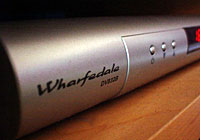 Picture quality
Picture quality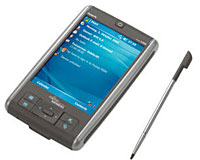 Fujitsu Siemens have launched the “first handhelds with fully integrated GPS functionality”, the Pocket LOOX N500 and Pocket LOOX N520 PDAs.
Fujitsu Siemens have launched the “first handhelds with fully integrated GPS functionality”, the Pocket LOOX N500 and Pocket LOOX N520 PDAs.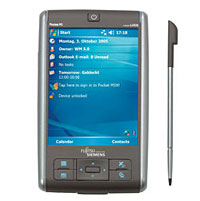 Powered by an Intel XScale PXA270 312 MHz CPU, the devices come with a SD/MMC slot (with support for SDIO), USB 1.1, IrDA and Bluetooth, with the Pocket LOOX N520 offering integrated wireless LAN 802.11g Wi-Fi.
Powered by an Intel XScale PXA270 312 MHz CPU, the devices come with a SD/MMC slot (with support for SDIO), USB 1.1, IrDA and Bluetooth, with the Pocket LOOX N520 offering integrated wireless LAN 802.11g Wi-Fi. There’s also a ton of Fujitsu Siemens-branded applications bundled in the package, including Voice recorder, AudioPath and Key Look, along with a Microsoft Mobile suite including Excel, Power Point, Outlook and Internet Explorer.
There’s also a ton of Fujitsu Siemens-branded applications bundled in the package, including Voice recorder, AudioPath and Key Look, along with a Microsoft Mobile suite including Excel, Power Point, Outlook and Internet Explorer. A Hong Kong doleboy has been slapped down by The Man after he was found guilty of distributing three Hollywood films using BitTorrent’s peer-to-peer file sharing technology.
A Hong Kong doleboy has been slapped down by The Man after he was found guilty of distributing three Hollywood films using BitTorrent’s peer-to-peer file sharing technology. The OpenSource BitTorrent software has become one of the most popular means of downloading large files, with the technology allowing users to download fragments of a large file from multiple users, rather than in one hefty lump.
The OpenSource BitTorrent software has become one of the most popular means of downloading large files, with the technology allowing users to download fragments of a large file from multiple users, rather than in one hefty lump. The futuristic vision of a connected home with content moving seamlessly from our TV to our PC and on to our mobile device is still a long way off, according to key speakers at The Connected Home conference in London today.
The futuristic vision of a connected home with content moving seamlessly from our TV to our PC and on to our mobile device is still a long way off, according to key speakers at The Connected Home conference in London today. It took Dimitri Van Kets (pictured left), from Belgian telco, Belgacom, to voice what many were thinking by announcing that the networked home was “little more than a mass of standards” and “too confusing” for the average consumer. Unless the service providers get together and educate customers, he said, true home connectivity was never going to happen.
It took Dimitri Van Kets (pictured left), from Belgian telco, Belgacom, to voice what many were thinking by announcing that the networked home was “little more than a mass of standards” and “too confusing” for the average consumer. Unless the service providers get together and educate customers, he said, true home connectivity was never going to happen. Paul Szucs of Sony said that service providers should “try not to lose the plot with content protection”, adding that “consumers simply want their devices to work together and share content.”
Paul Szucs of Sony said that service providers should “try not to lose the plot with content protection”, adding that “consumers simply want their devices to work together and share content.” BT is planning to turbo-boost broadband connectivity by quadrupling basic connectivity speeds to 8mbps nationwide and giving the service a snappy name, “ADSL Broadband Max”.
BT is planning to turbo-boost broadband connectivity by quadrupling basic connectivity speeds to 8mbps nationwide and giving the service a snappy name, “ADSL Broadband Max”.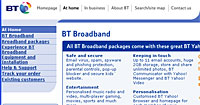 The 8mbps service will see BT reaching the theoretical top ADSL speeds it announced when the broadband service first launched in 2000.
The 8mbps service will see BT reaching the theoretical top ADSL speeds it announced when the broadband service first launched in 2000. With the industry rapidly consolidating, BT is coming under increasing pressure from newly merged uber-telecos like Telewest/NTL and Sky/Easynet, with the former already offering speeds of more than 8mbps for no extra charge on existing broadband subscriptions.
With the industry rapidly consolidating, BT is coming under increasing pressure from newly merged uber-telecos like Telewest/NTL and Sky/Easynet, with the former already offering speeds of more than 8mbps for no extra charge on existing broadband subscriptions. Elsewhere, BT has started trialling optical fibre broadband services in Wales, connecting business to ultra-high-bandwidth services using strands of blown fibre run along using existing telegraph poles.
Elsewhere, BT has started trialling optical fibre broadband services in Wales, connecting business to ultra-high-bandwidth services using strands of blown fibre run along using existing telegraph poles. Released today in Korea, the land where they get all the cool gadgets first, Samsung’s new SCH V700 handset has the honour of being the first PMP (Portable Media Player) phone in the world.
Released today in Korea, the land where they get all the cool gadgets first, Samsung’s new SCH V700 handset has the honour of being the first PMP (Portable Media Player) phone in the world.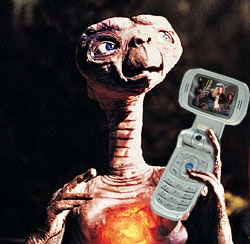 The V700 comes in Samsung’s favoured clamshell design with the added twist of a tilting display which lets users rotate the screen 90 degrees to take advantage of a wider display (it looks a bit like ET to us in this position, but maybe we’ve been overdoing it a bit recently.)
The V700 comes in Samsung’s favoured clamshell design with the added twist of a tilting display which lets users rotate the screen 90 degrees to take advantage of a wider display (it looks a bit like ET to us in this position, but maybe we’ve been overdoing it a bit recently.) We’re impressed with the onboard TV out port which could prive a great way of sharing your photos with chums.
We’re impressed with the onboard TV out port which could prive a great way of sharing your photos with chums.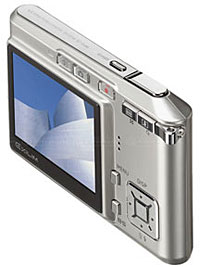 CASIO have announced their new, wafer-thin EXILIM CARD EX-S600 digital camera.
CASIO have announced their new, wafer-thin EXILIM CARD EX-S600 digital camera. According to Casio’s announcement, Revive Shot mode “adjusts for obliquity as well as brightly refreshes faded colours.”
According to Casio’s announcement, Revive Shot mode “adjusts for obliquity as well as brightly refreshes faded colours.” As is de rigeur on consumer compacts, there’s a built in movie mode with the Casio capturing MPEG-4, VGA (640×480 pixels) at 30 frames/second.
As is de rigeur on consumer compacts, there’s a built in movie mode with the Casio capturing MPEG-4, VGA (640×480 pixels) at 30 frames/second. Macrovision, a company who sell content protection (DRM) system, have today released a report they commissioned into content copying.
Macrovision, a company who sell content protection (DRM) system, have today released a report they commissioned into content copying. This is on the basis of what to us appears, from a quick once over of this report, a pretty unscientific approach, as the following paragraph from page 10 illustrates.
This is on the basis of what to us appears, from a quick once over of this report, a pretty unscientific approach, as the following paragraph from page 10 illustrates.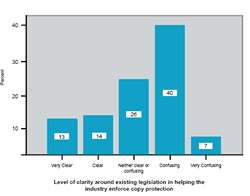 I hope that each time a ‘report’ or so called research like this is published, that it is gone through with a fine tooth comb pointing out its weaknesses. This kind of nonsense needs to be countered.
I hope that each time a ‘report’ or so called research like this is published, that it is gone through with a fine tooth comb pointing out its weaknesses. This kind of nonsense needs to be countered.